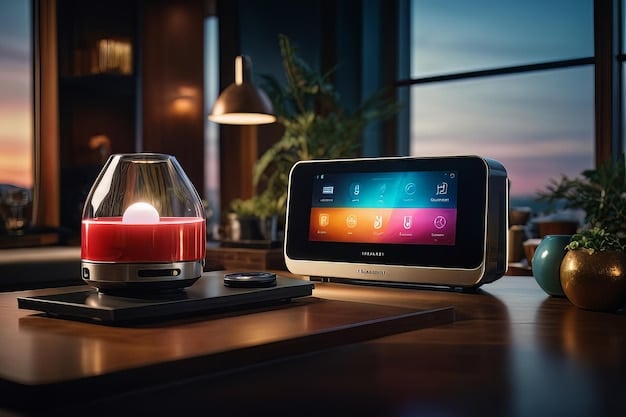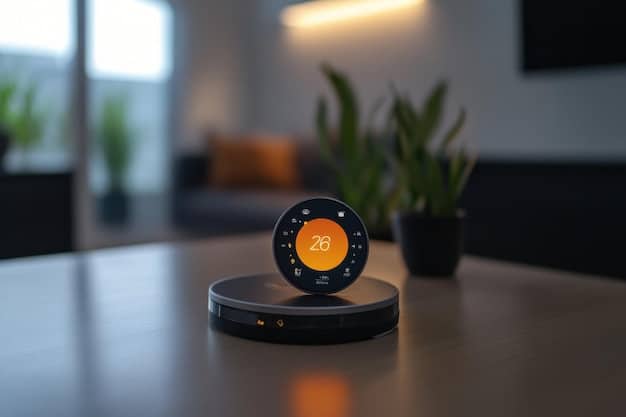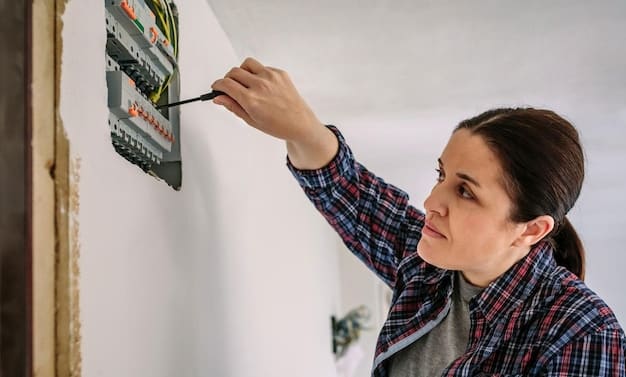Smart Home Energy Monitoring: Track Usage & Save Money

Smart home energy monitoring involves utilizing devices and systems to track your home’s energy consumption, pinpointing areas where you can optimize usage and reduce costs, ultimately leading to substantial savings and a more sustainable lifestyle.
Want to take control of your energy bills and reduce your carbon footprint? Smart home energy monitoring offers the perfect solution, allowing you to track your usage, identify energy hogs, and implement strategies for significant savings.
Understanding Smart Home Energy Monitoring
Smart home energy monitoring is more than just a tech trend; it’s a practical way to gain insight into your energy consumption habits. By understanding how much energy you use, and where it’s being used, you can make informed decisions to optimize efficiency and reduce unnecessary waste.
What is Energy Monitoring?
Energy monitoring involves tracking the amount of electricity, gas, or water consumed in your home over a specific period. This data helps you understand your energy usage patterns and identify areas where you can improve efficiency.
Why is it Important?
Monitoring your energy usage is essential for several reasons. It allows you to lower your utility bills, reduce your environmental impact, and ensure your home operates more efficiently. You’ll be surprised at how much you can save simply by being aware of your habits.
- Lower Utility Bills: Identify and eliminate energy waste.
- Reduce Environmental Impact: Decrease your carbon footprint by using less energy.
- Optimize Home Efficiency: Ensure appliances and systems are operating effectively.

In conclusion, understanding the basics of smart home energy monitoring is the first step towards a more energy-efficient and cost-effective lifestyle. By monitoring your consumption, you empower yourself to make smarter choices and reduce waste.
Benefits of Smart Home Energy Monitoring
Investing in smart home energy monitoring devices brings several advantages to your household. From reducing costs to enhancing convenience, these systems can transform the way you manage energy consumption in your home.
Cost Savings
One of the most immediate and compelling benefits of smart home energy monitoring is the potential for significant cost savings. By identifying energy-intensive appliances and usage patterns, you can make informed decisions to reduce waste and lower your bills.
Improved Energy Efficiency
Smart monitoring systems provide actionable insights into your energy usage, allowing you to improve your home’s overall energy efficiency. This might involve upgrading appliances, adjusting thermostat settings, or simply being more mindful of your consumption habits.
- Real-time Monitoring: Track energy usage in real time via smartphones or tablets.
- Detailed Reports: Receive comprehensive reports on energy consumption patterns.
- Custom Alerts: Set alerts to notify you of unusual energy spikes or waste.
In conclusion, the benefits of smart home energy monitoring extend beyond just cost savings. These systems empower homeowners to take control of their energy usage, improve efficiency, and contribute to a more sustainable lifestyle, all while enjoying enhanced convenience and peace of mind.
Choosing the Right Energy Monitoring System
Selecting the right energy monitoring system for your smart home requires careful consideration. With a variety of options available, it’s important to assess your specific needs and preferences to ensure you choose a system that aligns with your goals and lifestyle.
Factors to Consider
Several factors should influence your decision when choosing an energy monitoring system. These include your budget, the size of your home, the types of appliances you want to monitor, and your technical proficiency.
Types of Monitoring Systems
Energy monitoring systems come in various forms, each with its own set of features and capabilities. Understanding the different types can help you make an informed decision based on your specific needs and requirements.
- Whole-Home Monitoring Systems: Track energy usage for the entire house.
- Appliance-Specific Monitors: Monitor energy consumption for individual devices.
- Smart Thermostats: Control and monitor energy usage for heating and cooling systems.

In summary, choosing the right energy monitoring system involves careful evaluation of your specific needs and preferences. Consider factors such as budget, home size, and technical proficiency, and research the different types of systems available to find the perfect fit for your smart home.
Installation and Setup
The installation and setup of your smart home energy monitoring system can vary depending on the type of system you choose. While some systems are designed for easy DIY installation, others may require professional assistance. Understanding the installation process is crucial for a seamless and effective setup.
DIY vs. Professional Installation
Determine whether you can confidently install the system yourself or if you need to hire a professional. DIY installation is often more cost-effective, but professional installation ensures accuracy and minimizes the risk of errors.
Step-by-Step Guide
For DIY installations, follow a step-by-step guide to ensure you properly install the system. Consult the product manual and online resources for detailed instructions and helpful tips.
No specific subheadings or lists are needed here; just brief, informative paragraphs.
In conclusion, a successful installation and setup of your smart home energy monitoring system is essential for accurate data collection and effective energy management. Whether you opt for DIY or professional installation, ensure you follow the instructions carefully and address any issues promptly to maximize the benefits of your system.
Tips for Maximizing Energy Savings
Once your smart home energy monitoring system is up and running, it’s time to put the data it provides to good use. Maximizing energy savings requires implementing practical strategies and adopting energy-conscious habits that will help you reduce waste and lower your utility bills.
Identify Energy Hogs
Use your monitoring system to identify appliances or devices that consume the most energy. These “energy hogs” are prime targets for upgrades or adjustments that can significantly reduce your overall energy consumption.
Adjust Usage Habits
Based on the data you collect, make adjustments to your daily usage habits. This might involve turning off lights when you leave a room, unplugging devices when not in use, or using appliances during off-peak hours.
- Upgrade to Energy-Efficient Appliances: Replace old appliances with Energy Star-rated models.
- Use Smart Power Strips: Prevent vampire energy loss by automatically turning off devices when not in use.
- Schedule Appliance Usage: Utilize timers and smart outlets to control when appliances are powered on.
In summary, maximizing energy savings with your smart home monitoring system involves a combination of identifying energy hogs, adjusting usage habits, and implementing energy-efficient upgrades. By taking proactive steps and remaining mindful of your energy consumption, you can achieve significant savings and contribute to a more sustainable lifestyle.
Future Trends in Smart Home Energy Monitoring
The field of smart home energy monitoring is constantly evolving, with new technologies and innovations emerging regularly. Staying informed about future trends can help you make smart investment decisions and prepare your home for the energy-efficient advancements of tomorrow.
Integration with Renewable Energy Sources
One of the key trends in smart home energy monitoring is the increasing integration with renewable energy sources such as solar power. Systems are becoming more sophisticated in their ability to track and optimize the use of renewable energy, allowing homeowners to maximize their self-sufficiency and reduce their reliance on traditional energy grids.
Artificial Intelligence and Machine Learning
AI and machine learning are playing an increasingly important role in smart home energy monitoring. These technologies can analyze vast amounts of data to identify patterns, predict energy usage, and provide personalized recommendations for optimizing efficiency. AI-powered systems can also learn your habits over time and automatically adjust settings to save energy without requiring manual intervention.
- Advanced Analytics: Gain deeper insights into energy consumption patterns.
- Predictive Maintenance: Receive alerts about potential appliance malfunctions before they occur.
- Seamless Integration: Connect with other smart home devices and systems for a comprehensive energy management solution.
In conclusion, future trends in smart home energy monitoring are focused on enhancing integration, intelligence, and automation. As technology advances, homeowners can expect even more sophisticated tools and features that make it easier than ever to track, manage, and optimize their energy consumption.
| Key Point | Brief Description |
|---|---|
| 💡 Energy Monitoring | Track energy usage to identify savings. |
| 💰 Cost Savings | Reduce bills by optimizing consumption. |
| 🌱 Efficiency | Improve home energy efficiency. |
| 🤖 Future Trends | AI integration for better optimization. |
FAQ Section
▼
Smart home energy monitoring involves using devices and systems to track energy consumption in your home, providing data for making smarter energy choices.
▼
By identifying energy-intensive appliances and usage patterns, you can reduce waste, optimize your consumption, and lower your monthly utility bills substantially.
▼
You can monitor whole-home energy usage, individual appliance consumption, and the energy used by heating and cooling systems with smart thermostats.
▼
Yes, many systems are designed for DIY installation, but professional installation is recommended for complex setups or to ensure accuracy and safety.
▼
Keep an eye on integration with renewable energy sources and the use of AI and machine learning for advanced analytics and personalized energy optimization.
Conclusion
Smart home energy monitoring offers a powerful way to take control of your energy usage, reduce costs, and promote a more sustainable lifestyle. By understanding your energy consumption patterns and implementing practical strategies, you can make a significant impact on both your wallet and the environment.





